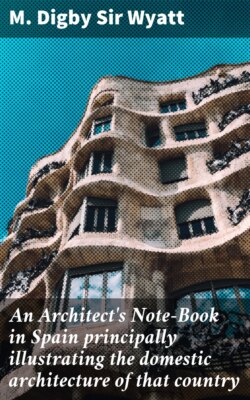Читать книгу An Architect's Note-Book in Spain principally illustrating the domestic architecture of that country - Sir M. Digby Wyatt - Страница 18
На сайте Литреса книга снята с продажи.
VALLADOLID. LA CASA DEL INFANTADO.
ОглавлениеAS in Italy, so in Spain, the architecture of the revival may be divided into at least two great schools, viz., the early, in which sculpture, and particularly sculptured arabesque, play a prominent part; and the late, in which regularity in the use of the orders and a system of rigidly proportioned plain architectural members form the main constituents of the most highly commended structures. Both merged into the extravagance which follows when architects learn to draw with facility rather than to think with steadfastness and propriety. As Italy had its Borromini, so had Spain its Churriguera.
The building from which my sketch has been taken, belongs to the second of these divisions of the architecture of the revival, as may be seen by the grave simplicity of the Ionic columns which support the massive but plain arches of both stories of a large and pretentious Patio. In this sketch I have chosen the point of view from the entrance loggia of the house, because looking from it I could well see, and therefore illustrate, the way in which a grand staircase, covered at the top, but open to the air upon one side, usually connects, in large houses, the upper and lower arcades of the Patios, and consequently the upper and lower floors of the mansion which open on to the two main arcades. The staircase is very rarely closed by iron-work or otherwise; consequently the visitor once obtaining access to the Patio was and is at liberty to ramble nearly all over the house unchecked. As front doors usually stand open from morning till night, access to Patios may generally be freely obtained; but where the house is inhabited by one family only, or by more than one family desiring privacy, iron or wooden doors usually close openings to the Patio such as are shown in the sketch. It is only when in answer to a bell, or knocker, attached to this or to an external doorway, a servant has appeared and ascertained that the visitor is an "amigo," that the door itself is opened, and access to the interior afforded.
It is a popular prejudice that gravity in Spanish architecture only came in with Herrera, after the middle of the fifteenth century in Spain, but in reality there were several other men who before him asserted their dissent from the plateresque redundancy of ornament, and designed works upon a careful study of Italian models of architectural proportion. Among such may be reckoned Pedro Machuca who in 1526 designed the palace of Charles V. at Granada, Alonzo Covarrubias who was architect for the noble staircase and cortile of the Alcazar at Toledo, and Diego Siloe who a few years later created the fine Cathedral of Granada.
